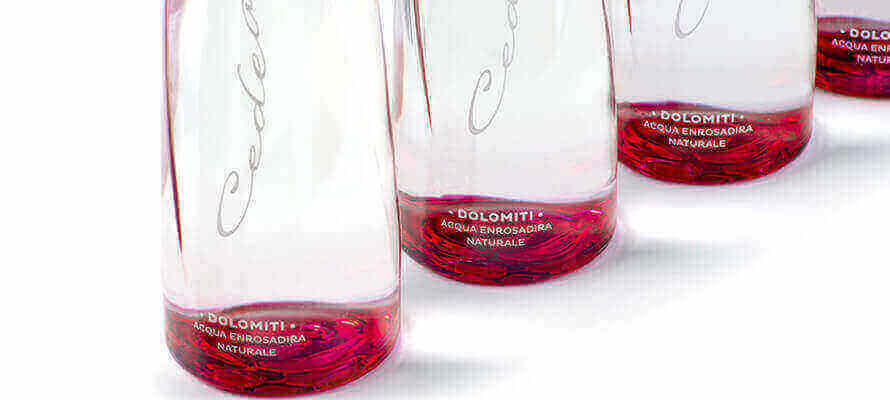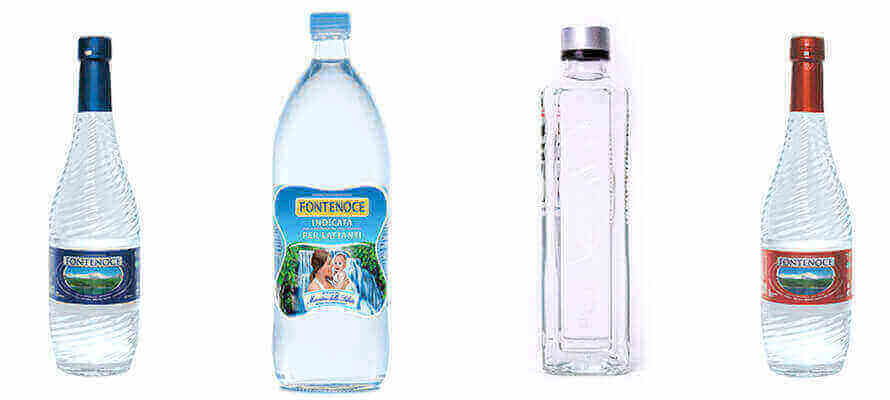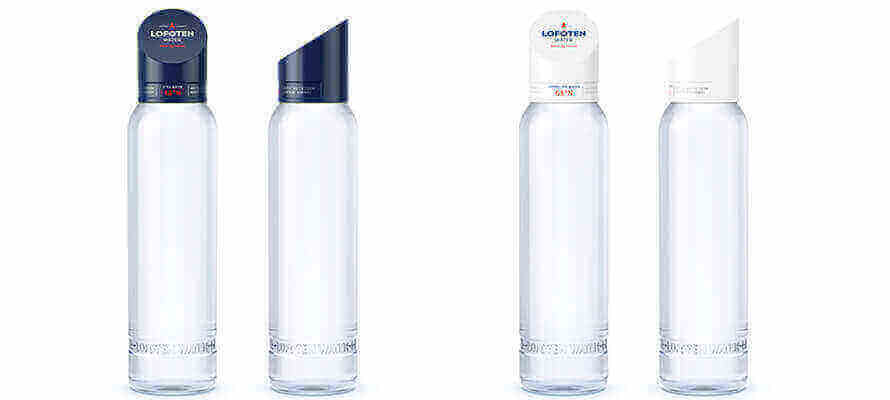Sculpting water
Glass packaging for mineral water is a technical and creative challenge loved by designers and architects. There’s a ductile raw material to be moulded, transparencies and colours that enhance the shapes, engravings and reliefs that dialogue with the closing systems and labels. But that’s not all: the design must meet essential functional requirements that preserve the purity of water, maintaining its qualities and protecting it from contamination. We talked about it with the managers of Sila – Acqua Fontenoce, Cedea and Lofoten Arctic Water, leaders in premium mineral water packaged in glass.
By Marilde Motta | On PRINT 83 | Versione Italiana
It was Perrier in the early 1900s - rounded and emerald green - that had the only “design” bottle, as we would say today. It remained the case for many decades because it was not until 1989, with the debut of Tŷ Nant, that the colour revolution took place. The shape of the glass bottle was always that of a club - the gymnastic apparatus but slightly longer. Still, the cobalt blue colour was an absolute novelty, and, within a few years, the mineral water bottle became the object of desire for architects and designers.
Measuring yourself against the design of new glass bottles was considered an opportunity as rewarding as designing a skyscraper, or almost. However, it is a complex challenge from both a creative and technical point of view since there is not only the container to be designed but also the closure system, labels and decors, as well as achieving efficiency in the filling lines and ergonomics for the consumer.
With its incandescent fluidity, glass adapts to the most extraordinary shapes enclosed in the moulds, offering crystal clear transparencies, colours that play with light, or sandblasted surfaces reminiscent of autumn frost. It also wisely protects the contents from the sun’s rays with the ultraviolet absorbing glass technique. Glass offers a very smooth surface to the decorations that today can also be made digitally with inks that do not compromise its recyclability. The processing of the outer and inner sides with engravings, high and low reliefs and modulation of the density of the glass provide the visual representation with effects of movement and, quoting Bernard Berenson, you could speak of enchanting “tactile values”. A large number of international design awards now have sections for glass packaging; there are awards for bottles for liquid food (especially oil and vinegar), and non-alcoholic beverages as well as spirits. In these competitions, the emphasis is on solid bottles that withstand turbulent bubbles of 6 atmospheres of pressure and those inspired by the great tradition of long-ageing wines. For water, there is the Global Bottled Water Award that enhances the work of designers, recognising the contribution of creativity in adding meaning and intrinsic value to brands, and making minerals memorable and immediately identifiable. An exhibition of bottles, which are sculptures for water, and the comparison of ideas with those managing large companies in this sector allow us to appreciate the glass packaging design for this asset, which is perhaps the most precious on Earth.
Why glass for containing water?
For Monica Menozzi, COO of Cedea, mineral water is an essential product in our daily consumption, but too often it goes unnoticed. “We wanted to put mineral water back on the scene, and we did so by choosing a glass bottle with an innovative design. It immediately shows the particularity of this water, which gushes out of a crack in the rock in the Dolomites, a geographical area declared a UNESCO World Heritage Site. Giuseppe Pascuzzo, CEO of Acqua Sila and Fontenoce, adds a further motivation for the choice of glass. “The Fontenoce children’s line of low mineral content water was created for the special needs of early childhood. The glass bottles are sterile and disposable to maintain the chemical and physical properties of our water, whose source is located in the uncontaminated environment of Sila, and prevent any transfer from the container to the contents.” The choice of glass is linked to reasons of preservation of both an uncontaminated environment and its purest water, as Ivar S. Williksen, president of Lofoten Arctic Water, also points out. “The water of the Arctic island Lofoten springs from mountains that were formed in the pre-Cambrian period and are located in a remote and solitary area in the far north of Norway.”
The source of inspiration
For the choice of glass, there is general agreement in bringing together environment, purity and sustainability. But when it comes to the design, the shape of the bottles and the elements that characterise their visual impact and experience of use, we see a competition of creativity - a very highly developed search for inspirational motifs. Some draw from the world of popular legends, from the image of the waves moved by the water current when it flows at its source, from rational geometric proportions, and pure and essential shapes. Monica Menozzi states her desire to enhance the design of every aspect of the spring and the environment that surrounds it. “The pink colour of the Dolomites at dawn and dusk, the rose flower that is part of the Cedea logo carved on the bottom of the bottle in bright pink, or in blue to distinguish sparkling water from natural water, are elements that define the visual identity of our bottles. They go alongside the twisting movement embossed on the glass, a sort of rotation that changes the profile of the bottle depending on the side from which you are looking at it. It’s a very sophisticated solution, like the choice of silk-screen printing the elements that make up the contents of the labels onto the glass, leaving complete space for light and transparency.” Lofoten’s choice is a firm reference to its local area and mountainous situation. While the body of the bottle is perfectly cylindrical and the label is almost invisible (made of transparent rPET), it is the closure system that makes the contents stand out and is entrusted with reminding us of the landscape of Lofoten’s sharp peaks. The hood rises angularly and vertically like the top of the mountains rising from the sea; the logo is printed there and a red arrow, like a compass’, pointing North. The colour is the deep icy blue of the waters around the island. Verallia designed and produced the bottle for Fontenoce, briefed by and in collaboration with Filippo Pascuzzo, who explains the origin of the wave shape printed on the glass. “Our water, when it flows at the source, moves a vortex of small waves; the glass faithfully reproduces them and gives the visual sensation of the water running, of its freshness”. The design of this bottle was awarded the Packaging Oscar in 2005. “The collaboration with Verallia,” adds Pascuzzo, “has also continued for the Fontenoce children’s water line, favouring a stripped-down model, made of flint glass, which is harmonious in its simplicity, but careful about ergonomics to facilitate grip and use.”
A look into the near future: What alternative channels are there for mineral water in glass packaging?
The HoReCa channel has been very badly affected during the Covid-19 hurricane. There was a long setback during the lockdown, which was applied all over Europe and in many of the countries that are the best markets for the most expensive mineral waters. Preventive measures and lower disposable income will strongly influence the resumption of activity in restaurants.
Filippo Pascuzzo explains, “In our case, in the Covid-19 period, the 1L VAP (disposable glass) product reached +30% in the pharmaceutical channel; it is a completely different market from HoReCa and certainly represents a niche that has so far been very little explored. At the same time, the door-to-door channel is reserved for bottling companies equipped with non-returnable glass systems organised with a widespread distribution structure and close to the source so they can rationalise the double transport cost. In other words, full and empty return.” Monica Menozzi thinks that the work done by the catering industry in recent years “has given consumers awareness and knowledge of mineral water, and has taught them to distinguish, to have preferences. HoReCa,” continues Menozzi, “will continue to be an important channel, but in parallel and certainly not as an alternative to the solution of home delivery of mineral water in glass bottles. I would talk about two tracks: catering has experienced an enforced stop and will start again with even greater awareness of its strategic economic importance; at the same time, home delivery will continue to grow because of transport convenience and guaranteed quality, which outweighs the higher price compared to the supermarket,” concludes Cedea’s COO. Ivar S. Williksen of Lofoten Arctic Water also agrees on the possibility of activating different channels. “The trends towards wellness and daily hydration have been firmly established, and we will continue to educate consumers and explain that not all waters are the same and you need to know their properties to make an informed choice. Obviously, the choice is made easier by making the product available, and the online sales solution is easy to put into practice”.
“Glass is class”
It is a common saying, but besides the aesthetic aspects, glass has unique safety properties, and its compact structure prevents the passage of contaminants. “In the case of water for children, the use of glass is an enforced choice,” Pascuzzo repeats, “and in this case, it is always disposable containers. In the case of returnable glass, if the glass does not release contaminants, there is always a minimal risk linked to poor or incomplete washing and wear of the container over time. It can’t give the consumer the safety of disposable glass, but still represents a valid alternative to PET.”
“The glass bottle is not even remotely comparable with the carafes that some restaurants have adopted,” Menozzi clarifies. “If we’re talking about premium mineral water, the glass bottle is at one with the product and with the image that the brand wants to give.” It’s a crystal clear message, like these rare waters.
—
Global Bottled Water Awards, the only award in the world for water packaging
Richard Hall is the founder and chairman of Zenith Global, a food & drinks consultancy based in Bath (UK) that organises the Global Bottled Water Awards. In this interview, Hall tells us how the international award he created has established itself as the centre of gravity where strategies, trends, research and innovations in the sector converge.
Water inspired your business idea. How did you develop it in the different activities of Zenith Global?
It was 1991, and it became clear to me that health would be the most significant influence on consumer behaviour for food and drink over the next 20 years. And that the main change in the drinks sector would be about bottled water. Essentially, our task was, first of all, to try to see, define and quantify the future, and then to help companies make the most of the opportunities on offer, including in terms of sustainability.
Global Bottled Water Awards was the first single-theme award and is still the only one in the water sector today. How has it changed over the years, and what are the foundations for the future?
We started with the design awards. Bottled water was a lifestyle accessory in many new markets, particularly premium glass on restaurant tables. Today we reflect the broader world of water through segments that include aromatic and functional water, and we’re taking note of technological innovations and social changes. An award like this is oxygen: it can make a small company more prominent and more credible, it can reinforce the credentials of a large company and is an extraordinary vehicle for promoting a product or concept.
How do you see the future of bottled water in terms of sustainability?
Water-based drinks have grown almost continuously over the last fifty years. Glass is still at the top, but daily hydration is the biggest driving force. There is currently real pressure on the impact of plastic and transport, but water uses less packaging, doesn’t travel as far and contains fewer ingredients and calories than other beverages. The key is finding improvements in collection and recycling to reduce the production of waste, followed by the use of new materials that are not derived from oil.
Coronavirus has also brought packaging to attention - how do you think glass can be seen in terms of safety?
All the existing types of packaging have very robust safety standards, and I have not seen any evidence that would question this in relation to the new coronavirus.





